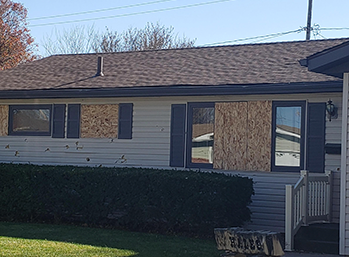Brick vs. Vinyl

Elevate Your Home's Aesthetic and Value with Brick
When it comes to cladding materials, clay brick reigns supreme over vinyl, offering a multitude of benefits that elevate both the aesthetic appeal and structural integrity of your home. Vinyl's superficial charm fades in comparison to brick's long lasting beauty, which withstands the test of time without succumbing to fading, chipping, or cracking. Brick's strength provides unparalleled protection against severe weather conditions, while vinyl may leave your home vulnerable to damage.
![]()
Recyclability:
Brick exceeds vinyl in terms of recyclability, fostering sustainable practices and minimizing environmental impact. It is a known fact that vinyl is plagued by contamination and ineffective recycling efforts, however brick is 100% recyclable and offers multiple avenues for reuse and recycling. Unfired or scrap brick can be seamlessly reintegrated into the production of new brick, closing the loop on resource consumption. With its superior recyclability compared to vinyl's limited options, brick emerges as the eco-friendly choice for cladding applications.
![]()
Investing in Longevity:
Brick's inherent durability and resistance to damage significantly reduce the frequency and expense of repairs. Unlike vinyl, which is susceptible to fading, cracking, and warping, brick maintains its integrity over time, minimizing the need for replacements or costly repairs year after year. Even the sun reflecting off energy efficient windows has been known to warp vinyl siding! Moreover, brick's superior insulating properties contribute to energy savings and lowering utility costs, which puts more money back in your pocket. In contrast, vinyl's poor insulating performance can lead to increased energy consumption and higher expenses.
![]()
Commitment to Safety:
When it comes to safeguarding your home and loved ones, brick emerges as the clear choice over vinyl siding. Clay brick's strength and resilience provide a formidable barrier against harsh weather conditions, protecting your home from the destructive force of high winds, flying debris, and hailstorms. Additionally, brick's noncombustible nature offers superior fire resistance, ensuring your home remains safe in the face of potential fire hazards. Vinyl, on the other hand, is susceptible to melting and spreading flames, posing a significant safety threat for your home.
Lets face it, vinyl lacks the durability, longevity, and sustainability of brick.
Consumer Perceptions and Environmental Concerns
Consumers often view vinyl siding negatively, describing it with terms like "cheap" and "flimsy." They point out its susceptibility to waviness, storm damage, curling seams, and uninspired design. Additionally, the manufacturing process for PVC, the base material for vinyl siding, produces hazardous materials, raising environmental concerns. While the vinyl industry maintains compliance with regulations, recycling vinyl siding remains challenging due to contamination.
Flammability and Impact Resistance
Vinyl siding poses flammability concerns, releasing toxic fumes when burned and smoldering for extended periods. This can lead to significant toxin exposure before fire detection. Tests indicate that vinyl siding can ignite from a fire six feet away in an adjacent dwelling. Furthermore, vinyl siding is susceptible to dents from hail, golf balls, or children's play, scratches from lawn tools, shrubbery, or trees, and stains from household chemicals.

Highlighted Resources
Comprehensive and Up-to-Date Insights into Brick's Enduring Performance Benefits

Melting vinyl plagues homes nationwide
Durability myths shattered as Vinyl siding melts on thousands of homes:


Brick vs. Vinyl
Homeowners with cracked stucco and water damage seek legal action against faulty installations:
More Cladding Comparisons
Find Your Brick Professional
BIA members manufacture brick, distribute clay brick, or provide products and services to the industry. Since many manufacturers and distributors have more than one location, you can find one near you.


.jpg/brick-city-house-bina-3%20(1)__480x316.jpg)
.jpg/3304%20-48%20On%20The%20Park%207%20(1)__480x320.jpg)